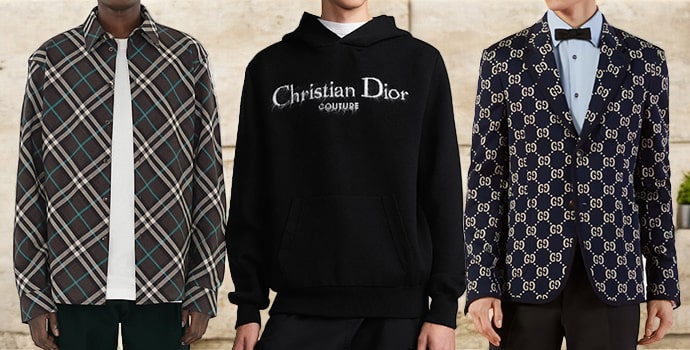Branded Clothing That Lasts: Choosing Fabrics for Longevity
Branded Clothing That Lasts: Choosing Fabrics for Longevity
Blog Article
Recognizing Apparel: The Value of Textile Options in Your Wardrobe
The selection of material in clothes plays a critical duty in both visual appeals and performance. Various materials provide differing levels of comfort, durability, and breathability, directly influencing the user's experience. Understanding these subtleties can improve one's closet significantly. Yet, several neglect just how these selections can impact not just personal design, however also sustainability. What textile choices could redefine your closet and align it with both style and duty?
The Duty of Material in vogue and Functionality

Common Fabric Kinds and Their Characteristics
When selecting clothes, comprehending the qualities of usual material types is important for making informed selections. Cotton, a widely-used all-natural fiber, is known for its breathability, soft qualities, and flexibility, making it ideal for casual wear and everyday garments. Linen, another natural choice, boasts excellent moisture-wicking residential or commercial properties and an unique appearance, perfect for warm climates.Wool, usually favored for its heat and toughness, varies in fineness; merino wool is soft against the skin, while coarser kinds are used for outerwear. Synthetic fabrics like polyester and nylon offer resilience and resistance to wrinkles, making them prominent for activewear and travel garments. Finally, blends, which combine artificial and all-natural fibers, can enhance functionality while preserving convenience. By identifying these textile characteristics, individuals can pick garments that aligns with their lifestyle and aesthetic choices.
Breathability and Convenience: Picking the Right Fabrics for Various Climates
Choosing the ideal textiles for numerous climates can substantially enhance convenience and total wearability. Breathable products are essential in warm environments, as they permit air flow and wetness evaporation. Fabrics such as cotton, bed linen, and moisture-wicking synthetics properly attract sweat away from the body, keeping the user cool and completely dry. Conversely, in chillier environments, thicker materials like woollen or fleece offer insulation while keeping breathability, guaranteeing heat without overheating.Additionally, the choice of textile weight plays an essential role; light-weight fabrics are preferable for summer, whereas much heavier options are matched for wintertime wear. Understanding the one-of-a-kind properties of each fabric allows individuals to dress appropriately for differing weather conditions. Ultimately, selecting breathable and comfy materials tailored to specific environments can considerably enhance daily comfort and enhance the general experience of wearing clothing.
Sturdiness and Treatment: Exactly How Textile Affects Durability of Your Wardrobe
Picking the best materials can significantly affect the durability and care demands of a wardrobe. Fabrics such as cotton and polyester are understood for their strength and ease of upkeep, making them perfect for everyday wear. In contrast, delicate materials like silk and shoelace need more cautious handling and specialized cleaning methods, which can raise the time and effort required for care. Branded Clothing.Durability is also influenced by the material's weave and finish; securely woven textiles have a tendency to resist damage better than freely woven alternatives. In addition, artificial blends typically offer enhanced resilience, incorporating the ideal qualities of numerous fibers.Understanding the care guidelines for each and every textile is crucial, as improper cleaning or drying out can bring about premature wear. Inevitably, picking durable products can lead to a longer-lasting closet, reducing the regularity of replacements and adding to an extra sustainable fashion option
The Effect of Material on Fit and Silhouette

Lasting Material Options: Making Eco-Friendly Decisions
The impact of textile prolongs beyond fit and shape to incorporate ecological aspects, prompting an expanding interest in sustainable fabric selections. Environment-friendly textiles, such as organic cotton, hemp, and Tencel, are getting traction among customers that focus on sustainability in their closets. These products are commonly created click this link with less chemicals and water, decreasing their ecological footprint.Additionally, recycled materials, made from post-consumer waste, supply a cutting-edge service to the fabric market's contamination issue. Brands increasingly accept transparency in their sourcing techniques, allowing consumers to make informed decisions regarding their purchases.Choosing sustainable textiles not just sustains ethical techniques however also encourages the apparel industry to embrace even more responsible manufacturing approaches. As awareness of environmental issues increases, individuals are advised to show on the additional info lasting influence of their textile choices, cultivating a motion in the direction of a more lasting and environmentally aware method to fashion.
Boosting Design: Just How Fabric Can Transform a Clothing
While numerous may concentrate on shade and cut when selecting a clothing, the selection of textile plays an important role in raising design and boosting general look. Different materials convey distinct moods and messages; as an example, silk exhibits high-end and elegance, while jeans supplies a laid-back, kicked back vibe. The structure and drape of a fabric can considerably alter the shape, with structured fabrics offering a polished look and softer ones producing a much more fluid, loosened up aesthetic.Moreover, the weight of the fabric affects wearability throughout periods. Light-weight textiles like bed linen and cotton are perfect for summer, while much heavier materials such as wool and velour give warmth and beauty in chillier months. Understanding material residential properties, such as breathability and stretch, likewise encourages people to make educated selections that improve comfort without jeopardizing style. Eventually, the appropriate fabric can change a clothing from average to remarkable, making it an important factor to consider in any type of wardrobe.
Frequently Asked Inquiries
Exactly how Do I Determine the Textile Content of My Garments?
To determine textile web content, one can check out treatment labels, conduct burn examinations for fiber recognition, or speak with fabric swatches. These techniques assist differentiate products, ensuring notified choices for clothes treatment and maintenance in daily wear.
Can Fabric Choice Affect My Mood or Confidence?
Material selection can substantially impact a person's mood and self-confidence. Branded Clothing. Certain materials might stimulate sensations of convenience or sophistication, while others can really feel limiting or unflattering, inevitably influencing self-perception and psychological well-being throughout the day
What Fabrics Are Best for Sensitive Skin?
For individuals with sensitive skin, all-natural textiles like bamboo, bed linen, and cotton are often recommended. These products are breathable, hypoallergenic, and much less most likely to create inflammation, making them ideal options for convenience and skin health and wellness.
Just how Do I Appropriately Laundry and Look After Different Fabrics?
To appropriately care and wash for various materials, one need to take into consideration each material's certain needs, consisting of temperature settings, cleaning agents, and drying out methods, guaranteeing long life and maintaining the material's original qualities for Click This Link excellent use.
Are There Particular Fabrics for Athletic or Performance Use?
Sports or performance wear typically uses materials such as nylon, polyester, and spandex. These products are developed for moisture-wicking, breathability, and versatility, improving motion and convenience throughout physical tasks while supplying durability and assistance. Alternatively, in colder environments, thicker fabrics like woollen or fleece supply insulation while preserving breathability, making certain heat without overheating.Additionally, the choice of material weight plays an essential function; light-weight fabrics are preferable for summertime, whereas larger choices are fit for wintertime wear. In contrast, fragile products like silk and shoelace call for even more careful handling and specialized cleaning approaches, which can enhance the time and initiative needed for care.Durability is also affected by the fabric's weave and coating; snugly woven materials often tend to withstand wear and tear much better than freely woven options. In contrast, rigid materials can restrict movement however offer a traditional, polished look.Moreover, the density and structure of the material can affect the visual understanding of body shape. The influence of material expands beyond fit and silhouette to encompass environmental variables, triggering a growing passion in lasting material options. The texture and drape of a material can considerably modify the shape, with structured materials giving a refined appearance and softer ones producing a more fluid, relaxed aesthetic.Moreover, the weight of the fabric affects wearability throughout seasons.
Report this page